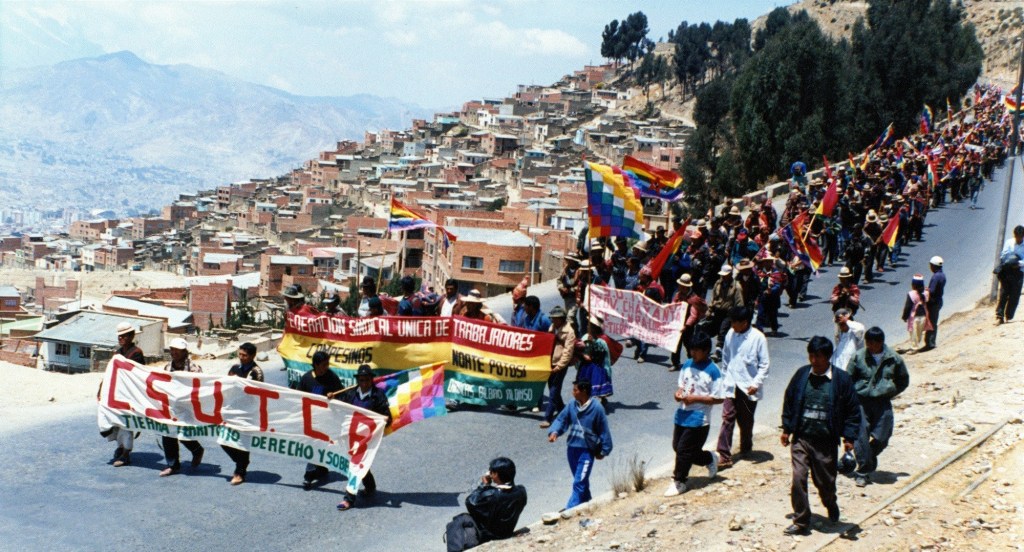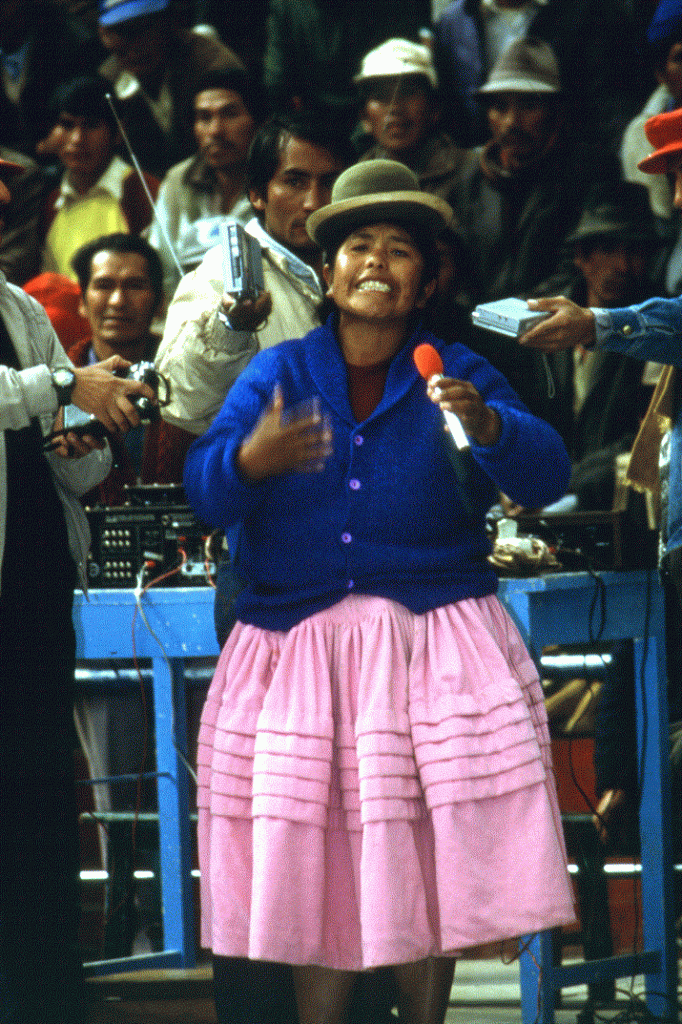
Benjamin Dangl’s The Five Hundred Year Rebellion: Indigenous Movements and the Decolonization of History in Bolivia (AK Press, 2019) is a vitally important book. Not only scholars and activists interested in the Bolivian struggles, but a wide range of oral historians, ethnographers and others will find the author’s pursuit of multiple hidden histories useful in their own work. That the volume bears a recommendation from Alessandro Portelli, the singular giant of Italian oral history, is a statement in itself: “Memory as a vision of the future, language as a tool of resistance, oral history as a form of struggle: Dangl gives us a brilliant, in-depth narrative of centuries of resistance grounded in culture. This is a story we should all know and learn from.” Language itself is, indeed, a tool of resistance—or can be.
Let us first introduce the author by way of his institutional connections because these weigh heavily in his work. For the better part of a decade, he has been editor of Toward Freedom, itself a singular publication. Publication began in 1952, at the height of the Cold War and also the anti-colonial rebellions, and it has remained a journalistic pillar of the struggle for a more egalitarian world, with a Global South free to go its own way.
We could usefully trace a longer trajectory back to Henry Demarest Lloyd, the late nineteenth-century “muckraker” who, in his condemnation of rising American corporations’ control of American politics, would remain among modern capitalism’s keenest critics. Henry’s son William Bross Lloyd financed the first Communist convention in the United States, in 1919, and his grandson William Jr. founded Toward Freedom, a publication carried on by Robin Lloyd and editorial collaborators—including TF’s current editor—ever since.
This history counts because Dangl is emphatically, usefully, part of the tradition. He is also a vital figure in today’s oral history movement, an academic or scholarly offshoot of the global search for the “bottom up” tradition. These traditions come together as Dangl approaches and embraces the indigenous movements in the Andean highlands of Bolivia, in and around La Paz, the capital.
Not many decades ago, histories of rebellions in Latin America searched out leaders and political parties or formations. In this version of history, indigenous people tended to be brushed aside as peripheral to modernity, “off the map,” or suitable mainly for anthropologists to record the last remnants of societies as much as extinct. As Dangl says in the book’s introduction, the post-colonial governments had good reason to cover up the vast crimes of European invasion and occupation: revealing that past would be opening capitalism’s own version of Pandora’s box.

Instead, the “official” nation (in Bolivia, typically, a mestizo-criollo elite, of European and the descendants of the intermarried) held the unofficial nation at a conceptual distance while exploiting the “Others” in every way possible. What has come to be called the “critical pedagogy of decolonization” opens up a different national narrative.
Crucial in this pedagogy, indeed to all oral history, is what Dangl calls the “window into meanings” that may not correspond with historical facts. The mythologies of resistance, carried on generation to generation and even century to century, have their own distinct place and value. Nicaragua’s Augusto Sandino was recovered from obscurity by a few scholars and then the Sandinistas themselves. The importance of this recovery applies to much more than heroic individuals. The dream of recovering forms of pre-conquest communal governance and labor production from centuries before the Incan empire, in Bolivia, may not correspond with history or probability. The cultural and political value of the oral history is scarcely less for this quality.
So: the memory both real and mythic of Tupac Katari, the indigenous general leading followers against the colonial Spanish-controlled capital in 1781, continued to stir memories almost two centuries later, when radical Aymara students in La Paz organized to honor his memory. The “Katarista” movements led resistance of various kinds against the military governments of Bolivia through many different kinds of action, to restore civilian rule, across decades. In the process, cultural symbols of old, upholding the indigenous people, came back into prominence, albeit more in cultural signifiers than politics as such.
Lamentably, in the meanwhile, the National Revolutionary Movement (MNR), seizing power in 1952 in the National Revolution and providing important reforms, had also determined to suppress indigenous identity in the name of national unity. Paternalism toward indigenous communities turned into repression and even massacres. Rural schools, welcome for their uplifting of the peasantry to literacy, nevertheless devoted energies to spreading Spanish literacy at the expense of indigenous languages. The next left-wing government, following decades of military rule, relied upon a campesino movement formed out of the Kataristas but hardly loyal to them.
In the process, the writings of indigenous intellectual Fausto Reinaga were widely read and are discussed to this day. Capturing the experience of the deprived, his work was further presented to the public by his niece, Hilda Reinaga, urging an “Incaic socialism.” Fausto Reinaga’s so-called “Indian thesis” captured the sensibility of the Kataristas and their efforts to mobilize through cultural symbols, with the help of NGO scholars. “We are foreigners in our own country,” a slogan of the newer movements, projected an Andean utopia upon the past and the future, with a manifesto translated into several indigenous languages. Indigenous dress replaced Western-style clothes at mass rallies, “our armor, our mandate.”

In the end, the indigenous movement could not defeat global capital—or, optimistically, has not defeated it yet. In chapter 4, Dangl turns to the “Andean Oral History Workshop,” where most uniquely oral history becomes a way of dealing with the contradictions and aspirations arising out of the Bolivian situation, including the waves of indigenous people moving into the cities for work. Marxism became a sort of lingua franca for the university populations, students and teachers, creating a useful tension between views of “underdevelopment” and efforts to find the unique features that helped explain the struggles around them.
Oral history, looking to practice rather than theoretical models, offered a way out. “Decolonizing” research, oral history workshops encouraged dialogue with existing communities. Certain stories, like that of indigenous peasant leader Santos Marka T’ula, offered a kind of collective saga against the dominant narrative. The use of radio to transmit the narratives pushed oral history into the “radionovela,” the novelistic radio drama that prompted indigenous survivors to meditate upon their own collective fate. It was “history come to life.”
Despite defeats both political and economic, despite everything, the “ayllus”—a form of rural community organization with pre-conquest roots—endure; this is Dangl’s last and most hopeful message. Back in the 1990s, Bolivia’s indigenous movements created a structure to recover and sustain the cooperative ethos deep in the history of the Andean people. “Governance, rotation of leadership and consensus-based decision-making”—these survive into neoliberalism and must survive as they have across the centuries. Crop and livestock diversification in a land of dramatic geographical differences existed long before the Spanish arrived, long before the Incas came to demand tribute. In some places, the names given to regional styles of work and life have miraculously survived to the present day, and offer a metaphorical way forward.
The tragedies continue as well. Evo Morales, who promised, and in some ways delivered at least needed recognition to the indigenous peoples, consolidated his rule at their expense. As he was pressed by the familiar enemy—the Monroe Doctrine with its promotion of U.S. corporations and their partners, domestic economic elites at the expense of common people—Morales himself returned to the drive for centralized state power.
In the acknowledgments, Ben Dangl recalls the extensive fieldwork and the Bolivian friends he made, the friends who helped to make this volume possible. If acknowledgments normally escape the reviewer’s attention, these do not: oral history is a journey, a journey that includes dedication to the subject and belief that the work produced will become available in some form and aid the struggles ahead.
Paul Buhle founded several oral history projects and taught oral history at Brown University. This article was produced by Globetrotter, a project of the Independent Media Institute.
